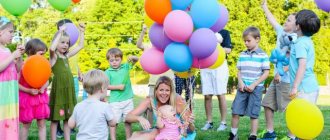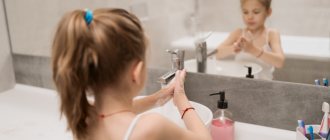Parent meeting “Age characteristics of young children”
Ostrovskaya Vera Arkadyevna,
MAUDO teacher
“Child Development Center – Kindergarten”,
Yalutorovsk
Goal: to deepen parents’ knowledge about the mental and physical characteristics of children in their third year of life.
Progress of the meeting
1. Greeting.
Hello, dear parents! We are glad that you found the time and desire to chat, talk about children, learn something new and interesting. First of all, let's get acquainted. I suggest everyone write their name on a piece of paper and attach it to their clothes, and you need to introduce yourself in this way: say your name and an epithet word that begins with the same letter, for example, Vera - faithful, etc.
2. Introduction to the topic of the meeting.
Your children have grown up and entered kindergarten. what has your child become, what has changed in him? Balloons will help you tell the story. Pass them along to music. At the end of the music, pop the balloon, take out the note and tell us how this feature manifests itself in your child.
(speech development, relationships with adults, Personality formation (self), play, memory)
3. Discussion and addition of parents’ statements.
Speech development - at this age the child learns to understand speech. It’s not for nothing that he loves to listen to adults talk. He likes to listen to stories, fairy tales, poems, nursery rhymes - this means that the child begins to explore the world with the help of language. An interesting fact: at 2-3 years old, a child’s vocabulary ranges from 300 to 1500 words. By the age of three, the child masters all cases and can construct complex sentences using prepositions.
The game is an objective game, because the object of knowledge is objects, their internal structure. The way of knowing is to disassemble, break. At this age, the child performs various actions with toys that he observed in adults, thus imitation games appear. Play at this age is often individual, and the child’s peers are of little interest to him. Only in the fourth year do children begin to show interest in a peer as a play partner.
Relationships with adults - an adult is interesting as a source of information, protection and affection. Therefore, a long separation is perceived painfully. But despite this, they manifest a need for independence, and personality formation occurs.
The formation of personality (I) is associated with the formation of self-awareness: he recognizes himself in the mirror, knows and responds to his name, realizes his place among his peers. Three- and four-year-olds begin to compare themselves with other people, their self-esteem and desire to meet the requirements of adults develop.
Memory development – involuntary memory, i.e. The child cannot specifically learn or remember any information. Only with repeated repetition does he form a memory. 75% of children's recall occurs at the age of 3-4 years, i.e. By the end of early childhood, long-term memory and its basic mechanisms are formed.
Conclusion: thus, personality formation, play, development of speech, memory, relationships with adults are the main directions in the development of children.
3. Exercises
Your child has changed, and your relationship with him must change too. I suggest you divide into groups according to the seasons. (cards “Winter”, “Spring”, “Summer”, “Autumn”). In groups, create your own recipe for the desired relationship between parents and child.
A recipe for desirable communication between parents and children
Take P_________, add P___________ to it, mix with a certain amount of P__________ L__________ and D__________, add your own O_____________, seasoned with loving maternal and paternal A_____________.
Now let's see what you got (recipes are read out).
Each recipe is unique and has the right to exist. You understand your position correctly. But I want to offer you one more recipe, maybe someone will take it into use.
Meaning of words:
Acceptance is an understanding of such love when a child understands that he is loved no matter what.
Recognition is the preservation of a child’s self-esteem and confidence.
Parental love - if you sow love and affection in childhood, you nurture and cherish it in adolescence, you will reap it in full in old age.
- remember how you affectionately call your child.
Conclusion: these gentle words are like stroking for a child and for a person in general. Psychologists say that 98% of children have never received physical support. To develop self-confidence, a child needs 3 strokes a day, for confidence in the family - 6 strokes, for confidence in society - 9 strokes, to be a leader - 12 strokes.
Availability means being ready to put aside your own affairs at any moment and communicate with your child.
Responsibility is acquired throughout life. Conditions for development: the presence of certain daily responsibilities; do not take responsibility for the child’s actions; the ability to say “No” to a child.
Conditions for the development of responsibility are the presence of certain daily responsibilities, not taking responsibility for the actions of children, the ability to tell the child: “No”
Authority is gained through years of dedicated parental work.
No matter what changes happen to the child, this recipe will always help us.
4. Tasks of work for the 2008-2009 academic year.
Speech development - by the end of the year, the child should name pieces of furniture and clothing. Toys, fruits, distinguish between wild and domestic animals. For the full development of speech, the group has play areas with various animal toys, a puppet theater, and a finger theater. The group learns rhymes, nursery rhymes, finger games. For the same purpose, the “White-sided Magpie” circle is held, the goal of which is to develop the child’s speech through oral folk art.
Artistic activity - hold a pencil correctly, make strokes, straight lines, know the primary colors (yellow, red, blue, green, black, white).
Modeling - roll plasticine in circular movements and straight movements.
Construction - distinguish between types of building materials - bricks, cubes, plates.
Development of self-service and cognitive skills - undressing and dressing independently, unbuttoning and fastening buttons, holding a spoon correctly, knowing the words of greeting and farewell, showing empathy for peers.
Physical education - we teach children to jump, run, respond to signals, and perform movements according to the text.
5. Exercises.
Game “Say a Word” (in a circle, parents pull out a piece of paper with an unfinished phrase and complete it)
- Memory in a 2-3 year old child... involuntary
- Game of young children... object-based
- At 2-3 years old, children’s vocabulary is ... 300-1500 words
— During modeling, a child learns to roll plasticine...in circular and...straight movements
— During construction, the child gets acquainted with the building material... the cube. brick, plate.
— By the end of the year, the child should name objects... furniture, clothes, dishes, toys, fruits, vegetables.
6. Summary. Reflection .
Game "Telegram".
Author: Ostrovskaya Vera Arkadyevna
We invite teachers of preschool education in the Tyumen region, Yamal-Nenets Autonomous Okrug and Khanty-Mansi Autonomous Okrug-Yugra to publish their teaching materials: - Pedagogical experience, original programs, teaching aids, presentations for classes, electronic games; — Personally developed notes and scenarios of educational activities, projects, master classes (including videos), forms of work with families and teachers.
Why is it profitable to publish with us?
1. “Kindergartens of the Tyumen Region” is an officially registered specialized media outlet at the federal level. 2. The activities of the editorial office are supported by the Department of Education and Science of the Tyumen Region 3. We issue a “Certificate of Publication” in the media. 4. The document has a unique number, is entered in the register, has the original seal of the editorial office of the online publication and signature. 5. “Certificate of publication” in the media is sent to the author in both paper and electronic versions.
Details >>>
Sample “Certificate of publication of author’s methodological material in the media.”pdf
Share


